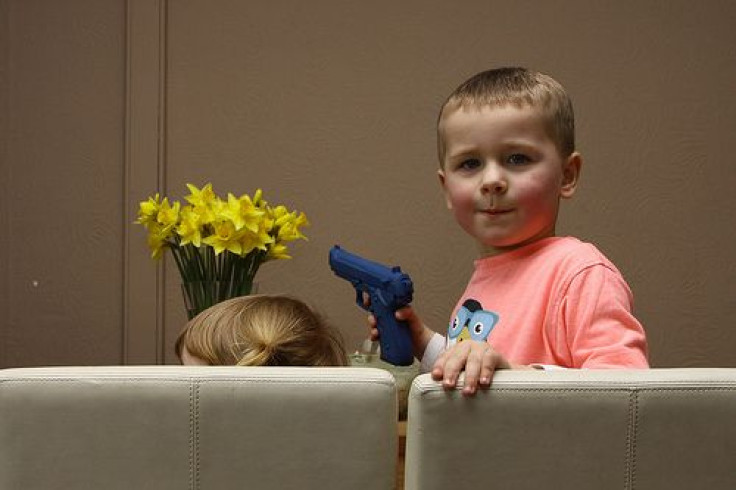Gun Use In PG-13 Movies At Record High, Surpassing R-Rated Movies: Should We Fear The Weapons Effect?

It’s probably not hard to believe that crime films, westerns, and other cinematic twists on the “shoot-em-up” appeal to a younger audience. They’re loud, action-packed, dangerous – all the things kids can’t be at home. But a new study has found gun use in movies is not only rising, but rising among PG-13 movies in particular, faster even than the supposedly more gratuitous R-rated films. Now researchers are curious whether this increased exposure has negative effects on young viewers, who may become more aggressive in the sheer presence of a gun.
Since the original research was conducted in 1967, scientists have wondered whether people become more aggressive when they’re primed with a weapon in front of them. They call it the “weapons effect.” The present study asks a follow-up question, namely, should we fear the weapons effect taking place given that, since 1985, gun use in PG-13 movies has more than tripled?
The researchers posing this question first collected data from the 30 top-grossing films each year from 1950 to 2012, and analyzed each film for how many five-minute segments of violence it contained for each character. Of special note were films after 1985, which was the year the Motion Picture Association of America (MPAA) first introduced the PG-13 rating. Overall, violent scenes quadrupled between 1950 and 2010. Since 1985, 94 percent of all movies studied contained at least one violent segment.
On-screen violence held steady among R-rated movies, at 1.54 segments per hour, and among G- and PG-rated movies, at 0.41 segments per hour. Surprisingly, however, PG-13 movies rose incrementally from 1985, when virtually no violence took place on-screen, to 2005, at which time violence began to increase dramatically. By 2010, PG-13 movies were as violent as R-rated movies. By 2012, they had surpassed them.
“The trend of increasing gun violence in PG-13 movies is disturbing because of what we know about the weapons effect and because those are the films kids are most attracted to,” Brad Bushman, co-author of the study and professor of communication and psychology at The Ohio State University, said in a statement.
As a principle of social psychology, the weapons effect has been invoked countless times as a way to explain school shootings, such as the 1999 massacre at Columbine High where two seniors killed 13 people wearing Matrix-style garb, and other random acts of violence, such as the 2012 Aurora, CO shooting whose assailant was apprehended with hair dyed red and called himself “The Joker.”
“Seeing these violent gun scenes in movies may be strengthening the weapons effect among young people,” Bushman said. “In addition, these movies essentially provide young people scripts for how to use guns in real life, as we have seen in copycat killings. It is a bad situation.”
Some have rejected the weapons effect, however. There are nearly 50 incarnations of the original weapons effect study published in the scientific literature. Critics of the effect speculate that any anticipation or expectation of the intended result skews the result. In other words, the effect is so popular that any subject who is exposed to the study will recognize its purpose and act out of bias, rather than impulse. Other criticisms highlight that guns aren’t strictly used offensively; millions of gun owners purchase guns specifically to defend themselves. The structure of the weapons effect study presumes the gun will be used to harm, not protect, critics assert.
A 1993 study, however, counters those arguments by suggesting that the mere presence of a gun in the home accounts for 60 percent more homicides than homes without guns.
“Our data strongly suggest that the risk of homicide is markedly increased in homes where a person has previously been hit or hurt in a family fight,” the researchers wrote. “At the very least, this observation should prompt physicians, social workers, law-enforcement officers, and the courts to work harder to identify and protect victims of battering and other forms of family violence.”
Moving forward, much of the attention has shifted from movies and television to video games, an ever-expanding medium that not only has fewer constraints than film, but allows people to interact, rather than just spectate.
Of course, the great controversy surrounding the weapons effect in media is determining which direction the correlation goes. Do children become more violent through violent media, or do kids who are already pre-disposed to be more violent – through life experience, trauma – gravitate towards those media? Dr. Brian Iacoviello, Assistant Professor in the Icahn School of Medicine at Mount Sinai’s Department of Psychiatry, argues the chance a child will develop new habits from fictional media is slim at best.
“Perhaps in children and adolescents, whose prefrontal cortex (the parts of the brain responsible for higher-order thinking, metacognition, and logic) continue to develop until around age 25, this process goes differently or more slowly,” he said. “But children and adolescents are confronted with realistic stimuli at times (seeing a real-life accident or injury and it's real-life consequences, for example) and generally appear able to distinguish reality from fantasy.”
Iacoviello, who wasn’t involved with the latest study, said that even though most adults at one time or another absorb a film’s sentiments – "Gee, maybe something like that could actually happen in my life” – the logical part of the brain takes over and reminds us what is real. The difference in children, he argues, is only marginal.
“There are many youngsters who see weapons in games and movies that do not go on to be aggressive or use weapons, which would be contrary to the theory,” he said. “Research seems to support more strongly the hypothesis that aggressive and antisocial personality characteristics, often developing after traumatic life experiences, are more likely to result in aggressive acts than simply being close to a weapon.”
Study: Bushman B, Jamieson P, Weitz I, Romer D. Gun Violence Trends in Movies. Pediatrics. 2013.



























